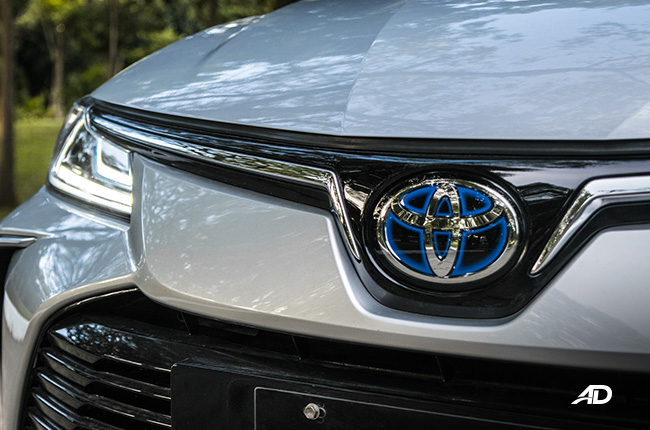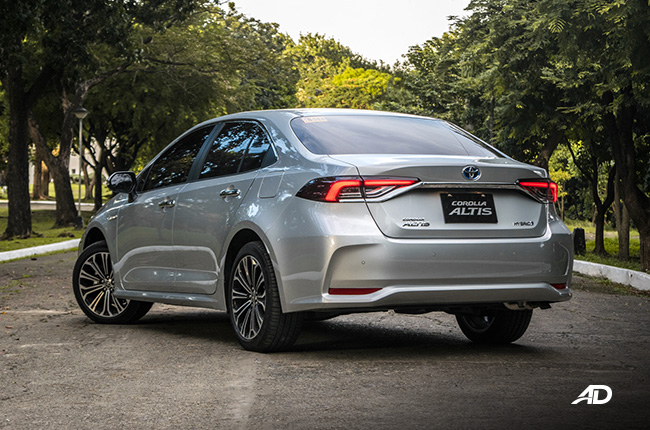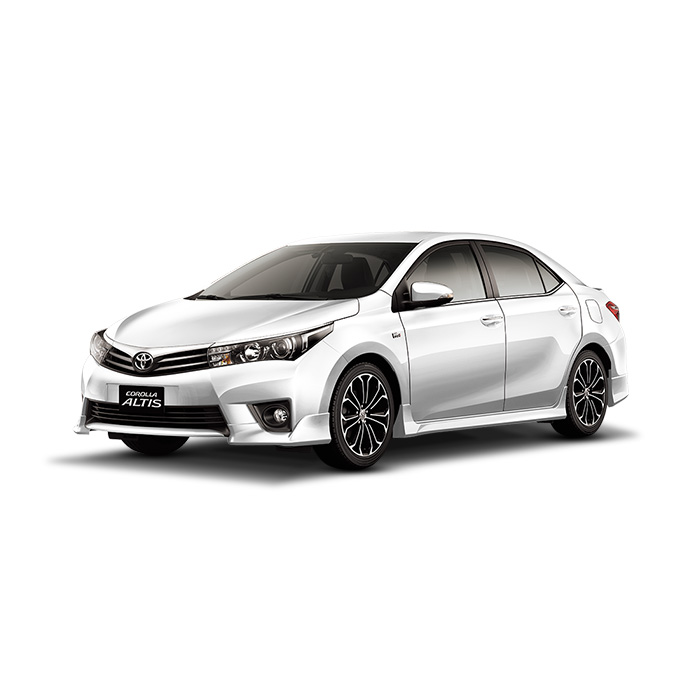
Contents
Okay, let’s put it this way – 44 million Toyota Corolla units have been sold globally in 2016. This milestone made the Toyota compact car the best-selling nameplate in the world, putting the Volkswagen Beetle on its rearview mirror. With that said and with 12 generations of Corolla since 1966, it’s safe to say that the Corolla is extremely popular, not only in the Philippines but in other countries as well.
Locally, where the small crown is currently known as the Corolla Altis, the nameplate’s popularity can be attributed to its bulletproof reliability – a trait shared with the rest of the Toyota vehicles. Heck, you can even see a big-body Corolla E100 from the ‘90s on the road today.
So, how do you reinvent a well-known car? Toyota opted for electrification, and that’s what we have this week for this review – the first-ever Corolla Altis Hybrid in the Philippines.
Engine Output (HP), Acceleration, Transmission, Handling 4.0/5
Exterior & Interior Design, Quality, Fit and Finish, Ergonomics 4.0/5
Cabin Comfort, Suspension, NVH Insulation 4.5/5
Convenience Technologies, Active and Passive Safety Features 4.0/5
Amount of the vehicle you get for the price, Fuel Efficiency 4.0/5
- Toyota Safety Sense is a pleasure to have in a car.
- Extremely fuel-efficient hybrid powertrain.
- The best-looking Corolla Altis. Ever.
- Boat-loads of piano-black plastics found in the cabin.
- Lackluster touchscreen infotainment system.
- Cluttered instrument cluster.
Exterior
Now, don’t get us wrong, the Corolla already got its first hybrid in the 11th iteration in 2012, but this is the first time that the Philippines gets the electrified version in order to align with Toyota Motor Philippines’ push for hybrid cars. It’s also the first time that the Corolla Altis' design has invoked an emotion on me – at least with its front fascia. The sharp DRLs, bi-LED headlights, defined chisels, and Camry-like styling all make for an imposing face, reflected at the rear with a taillight shape that’s reminiscent of the RAV4.
I can’t say the same for styling in profile, though. If there’s anything carried over from the Corolla Altis’ predecessor, that would be the rather plain facade when viewed from the side. Good thing the 17-inch alloys are creatively-designed, so that gets a thumbs up in my book.
On a side note, it’s such a shame that we didn’t get the Sporty Corolla here (known as the Levin in other markets) but I’ll take the Corolla Altis’ new face over its rather vanilla predecessors any time. As I’ve mentioned, this is the first time that I liked the Corolla Altis’ styling and I sure do hope Toyota soldiers on with this design outlook in the years to come.
Interior
While it’s an overall positive remark with the Corolla Altis’ exterior design, the cabin is just on the average when it comes to layout, quality of materials, and feel. Boat-loads of scratch-prone piano black plastics can be found on the dashboard, around the gear lever, and on the inner door handles. Other hard plastics found on the cabin can appear a bit tacky for the picky buyers. The front cupholders are also small, while the storage on door pockets is limited. There are only quite a few cubbyholes, too.
The cabin’s saving grace would be the generous soft leather on the upper dashboard, door cushions, and console box cover – all making sure that your elbows are well-cushioned while driving. I particularly like the smartphone cradle underneath the dashboard, as well, since it can accommodate my iPhone XS Max. On the other hand, trunk space is ample, enough to do its intended purpose as a family sedan (groceries, shopping, and luggage for out-of-town trips).
Probably the biggest let down in the Corolla Altis cabin would be the infotainment system and instrument cluster. While the touchscreen head unit works just fine, the thick piano-black bezels, lackluster display, and missing tactile knobs/buttons aren’t the prettiest and most logical you’ll see in this segment. Lastly, the LCD trip computer in between the bright blue gauge clusters is crowded, with icons scattered all over the place. This won’t be a problem for techie car buyers but will definitely be irksome for those accustomed to simplicity.
Comfort
Overall ride comfort was the Corolla Altis’ primary selling point in its previous modern iterations. Well, it still is and kudos to Toyota for keeping faith with this. The suspension setup is enough to absorb road imperfections well, negating the impact on the passengers.
The compact sedan’s cabin can be quite spacious, just as long as there’s no occupant taller than 5’8”. Five people could fit quite squarely without complaints – all would be cool and cozy with air-conditioning vents found on both front and rear cabins. NVH insulation is also notably top-notch, plus the fact that having an EV-biased hybrid system means that there would only be rare times you would hear the engine roaring from inside.
If there’s any complaint, though, that would be on the driver’s seat. I stand at 5’6”, fairly-built, but it felt like the seats were just big enough to support my posterior footprint with very little margin. But what if the driver’s wider and taller?
Technology
Beyond the LCD display woes, the Corolla Altis is adequately equipped when it comes to tech toys and features. Everything’s electronic and power-assisted, plus the lack of Apple CarPlay and Android Auto is okay since the sound from the 6-speaker setup is more than decent. Sensors and a basic rear camera (without guidelines) are present to assist you with parking. The car comes with adaptive cruise control and land-keeping aids, too, which are very welcome additions at this price point.
I just wish Toyota could add more USB charging ports, however. If you would like to power up your smartphone while on the road, your only choice would be via the infotainment system – which means your chord will dangle around the front air space – or by using an accessory charger plugged on the 12V socket inside the deep console box.
Safety

When it comes to safety, you can never go wrong with how Toyota fills out its spec sheet. Seven airbags, ABD with EBD, ISOFIX child seat tethers, seatbelt reminders, and stability control are available across the Toyota Corolla Altis range – but that’s not all.
The top-spec Corolla Altis Hybrid is also the first Toyota in the country to come standard with Toyota Safety Sense – the brand’s suite of active and passive safety toys. These features include the aforementioned adaptive cruise control and lane keep assist, along with lane departure warning, automatic high beam (works like a charm, by the way), and a pre-collision system. The radar cruise control was a trip to use on the highway. The lane-keep aid needs a bit of refinement, though, as the steering correction felt a bit harsh and restless at some point.
Driving & Handling

The Corolla Altis Hybrid’s engine performance was similar to a conventional fuel-powered car. Granted, this Toyota may be biased in using its EV mode during normal driving circumstances, but it’s not as if you’re driving a spaceship. It’s just the same, but with a few deviations. But before that, let it be known that the Corolla Altis isn’t a sporty car – its combined output of 121 hp and 142 Nm torque are numbers enough for sensible and comfortable driving.
With that said, don’t expect fast drives with the Corolla Altis, although you still can with deeper presses on the throttle. The 1.8L gasoline engine would roar (with a rather distasteful sound) at this point and you’ll find yourself reaching speeds at ease. The CVT works seamlessly on the background as well, adding to the remarkable driving comfort. Braking, on the other hand, felt artificial because of the regenerative mechanism employed in order to charge the battery, but it won’t be hard to get accustomed to.
The Corolla Hybrid’s TNGA platform proved wonders in terms of handling. The car felt stable, even during fast drives, plus it stayed composed on winding roads, provided that you’re doing reasonable speeds. There was no feeling of uncertainty at any given point.
Fuel Consumption

Of course, the Corolla Altis Hybrid’s fuel consumption is its strongest trait, otherwise, it would be pointless. But how thrifty, really?
After an hour on northbound EDSA that started at around 4:00 p.m., the car returned 14.2 km/L. A leisurely drive on a Sunday clocked in 26.2 km/L on an average speed of 60 km/h. The best fuel economy number I got with the Corolla Hybrid was 29.7 km/L – that’s after an hour on the highway with the cruise control set at 90 km/h.
Of note, these numbers are better than our initial Corolla Altis Hybrid fuel efficiency testing, which was done with five people on board.
Verdict

It’s understandable if you’ll feel skeptical about getting a hybrid vehicle. After all, it’s the first time that Toyota Motor Philippines has entered the mainstream marketplace with a hybrid car (No. Not you, Prius). People aren’t hard-wired to accept new things instantly, that’s for sure.
But after driving the Corolla Altis Hybrid for a week for this review, I learned one thing: it’s no different from a vehicle with an internal combustion engine – except when you start the car up, which is as silent as a teenager escaping in the middle of the night.
With that said, I can’t wrap my head around the fact that the Corolla Altis Hybrid isn’t taking off in the local market just yet. It looks good, drives comfortably, and most importantly, it's extremely fuel-efficient. Sure, there are compromises warranted for its interior amenities but at this price point, at P1,580,000 for the non-White Pearl Hybrid variant, the Toyota compact sedan is already a bargain that everyone should welcome.
Exterior Photo Gallery
Interior Photo Gallery
Specifications
Engine
1.8 LFuel Type
HybridPerformance
121 hp @ 5,200 rpmTransmission
CVT-
Summary
-
Name Toyota Corolla Altis 1.8 V Hybrid CVT Body Type Sedan Price ₱1,595,000 Transmission Category CVT -
Engine
-
Engine Size 1.8 L Displacement 1,796 cc Number of Cylinders 4 Number of Valves 16 Transmission Type Continuously Variable Transmission (CVT) -
Performance
-
Drivetrain Front-Wheel Drive Max Output (hp) 121 hp @ 5,200 rpm Max Torque (nm) 142 Nm @ 3,600 rpm -
Economy & Environment
-
Fuel Type Hybrid Emissions Standard n/a Fuel Capacity 43.0 L *Combined Fuel Consumption 4.1 km/L *brand manufacturer claim
-
Dimensions
-
Length 4,630 mm Width 1,780 mm Height 1,455 mm Wheelbase 2,700 mm Turning Circle 11 m Ground Clearance 140 mm Trunk Capacity 581 L Number of Doors 4 Number of Seats 5 -
Safety & Security
-
Driver's Airbag 1 Front Passenger's Airbag 1 Side Airbag 2 Curtain Airbag 2 Knee Airbag 1 Auto Brake System Electronic Brake Distribution Anti-lock Brake System (ABS) with Electronic Brake Force Distribution and Brake Assist
Immobilizer Security Alarm Stability Control Electronic Door Locks Speed Sensing Door Locks ISOFIX Lane Departure Warning System Blind-Spot Detection System -
Features
-
Cruise Control Front Parking Sensors Rear Parking Sensors Leather Upholstery Push Start Button Wheel Size 17 in Wheels Metal Type Alloy Airconditioning System Automatic Climate Control Entertainment System Display Audio with CD/DVD/MP3/USB/Aux/Bluetooth Connectivity Aux, USB, and Bluetooth Navigation Ready Warranty 3 Years (100,000 km) Keyless Entry Roof Rack Sunroof Electric Adjustable Seats Power Steering Power Windows Power Outlet Steering Wheel Audio Control -
Technology
-
Active Park Assist Hill Start Assist AWD Modes n/a Tire Pressure Monitoring Heads-up Display Power Liftgate Start-stop System
Colors
Latest Review
-
Addictively excessive: The Ford Ranger Raptor Twin Turbo V6 / Review
The Ford Ranger Raptor Twin Turbo V6 is one crazy pickup truck. Wondering why? Just keep reading.
4.6 / 5 -
The Kia Carnival gives you more: More seats, more comfort, and more practicality / Review
The Kia Carnival is a three-row MPV designed for executives and families. It combines comfort, technology, and practicality, making it a strong choice for those looking for a premium people...
4.2 / 5 -
The Jetour Ice Cream: A pint-sized EV that’s hard to ignore / Review
The Jetour Ice Cream is an adorable, pint-sized electric car that’s made for the city. Affordable and stylish, it’s easy to love, but does it tick all the boxes for you?
3.7 / 5
Popular Articles
-
Cheapest cars under P700,000 in the Philippines
Jerome Tresvalles · Sep 02, 2024
-
First car or next car, the Ford EcoSport is a tough package to beat
Jun 18, 2021
-
Car Maintenance checklist and guide – here’s everything you need to know
Earl Lee · Jan 12, 2021
-
Most fuel efficient family cars in the Philippines
Bryan Aaron Rivera · Nov 27, 2020
-
2021 Geely Okavango — Everything you need to know
Joey Deriquito · Nov 19, 2020
-
Family cars in the Philippines with the biggest trunks
Sep 20, 2023
-
Head to head: Toyota Rush vs. Suzuki XL7
Joey Deriquito · Oct 28, 2020
-
Why oil changes are important for your car
Earl Lee · Nov 10, 2020
-
2021 Kia Stonic — What you need to know about it
Joey Deriquito · Oct 16, 2020
-
Top 7 tips for buying a used car in the Philippines
Joey Deriquito · Nov 26, 2020


























